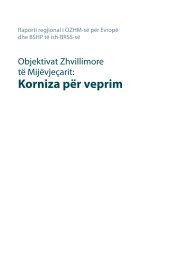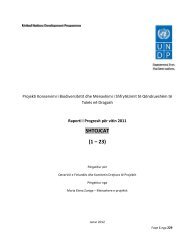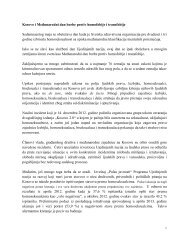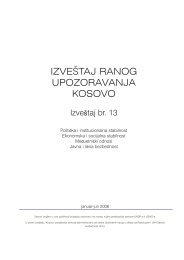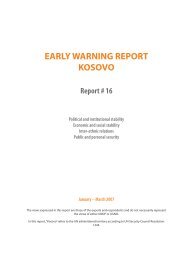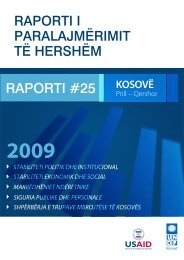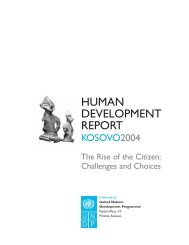Kosovo Human Development Report 2010 - UNDP Kosovo - United ...
Kosovo Human Development Report 2010 - UNDP Kosovo - United ...
Kosovo Human Development Report 2010 - UNDP Kosovo - United ...
Create successful ePaper yourself
Turn your PDF publications into a flip-book with our unique Google optimized e-Paper software.
FIGURe<br />
0%<br />
4.1<br />
5%<br />
10%<br />
Total expenditures on health as a % of GDP<br />
15%<br />
20%<br />
USa FRa GeR aUT GRe Slo bIH MaC SeR CRo blG MNG alb KoS<br />
Source: WHO SIS (except <strong>Kosovo</strong> source MEF 2008)<br />
tend to have systematically higher morbidity<br />
and mortality rates. 133 Economically<br />
inactive men, for instance, have<br />
higher risks of premature death than<br />
those observed for employed men. Research<br />
over the last 15 years shows significant<br />
correlation between socio-economic<br />
status and health. On average,<br />
the more advantaged the individuals<br />
are, the better their health is – whether<br />
measured in terms of disease and<br />
mortality134 or in terms of self-assessed<br />
physical and psycho-social health. 135 In<br />
<strong>Kosovo</strong> one third of the population has<br />
limited access to drinkable water and<br />
proper sanitation – with deprivation<br />
rising steeply among the poorest quintiles.<br />
The effect of poverty on exclusion<br />
is compounded by social fractures that<br />
prevent communities collaborating to<br />
improve universal health access. <strong>Kosovo</strong>’s<br />
bitter inter-ethnic divides are one<br />
example, as <strong>Kosovo</strong>-Serbs refuse to<br />
seek services from health facilities run<br />
by <strong>Kosovo</strong>-Albanians, and vice versa.<br />
(iii) Multiple challenges in accessing<br />
health care providers: <strong>Kosovo</strong> has<br />
70 | KOSOVO HUMAN DEVELOPMENT REPORT <strong>2010</strong><br />
15.3% 11.1% 10.4% 9.9% 9.9% 8.4% 8.3% 8.2% 7.6% 7.5% 6.9% 6.8% 6.2% 3.0%<br />
an extensive network of public health<br />
facilities, and the number of licensed<br />
and functional private health facilities<br />
is on the rise. 136 Over 80 percent of the<br />
population has access to some level of<br />
primary care within 10 minutes, and 99<br />
percent within 20 minutes. However,<br />
the distance to a health care provider<br />
is not the only factor affecting inclusion.<br />
In <strong>UNDP</strong>’s <strong>Kosovo</strong> Mosaic Survey<br />
(2009), the respondents were asked<br />
to answer the following question on<br />
health care: On the last occasion you<br />
needed to see a doctor or medical specialist,<br />
to what extent did each of the<br />
following factors make it difficult for<br />
you to do so?<br />
1. Distance to doctor’s office/ hospital/<br />
medical centre;<br />
2. Delay in getting appointment;<br />
3. Waiting time to see doctor on day<br />
of appointment;<br />
4. Cost of seeing the doctor; and<br />
5. Cost of buying medicines.<br />
The largest proportion perceived that<br />
they had to overcome all five factors to<br />
access the necessary health care. As Table<br />
4.4 demonstrates, men experience



